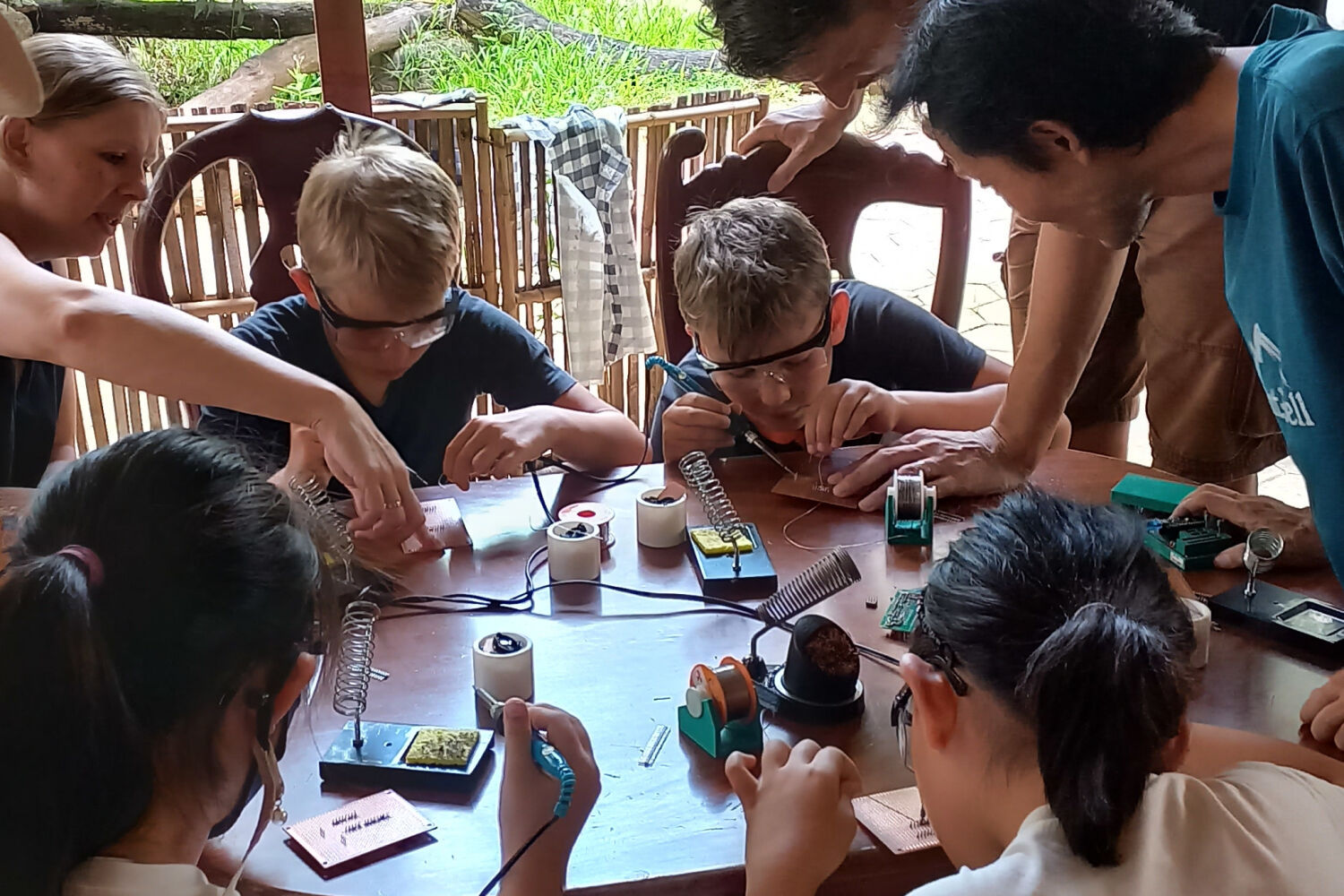Updated:
The last Sunday was the longest day in my life in Cambodia: the first day of my class for kids at Makers Siem Reap. Here is the summary.

The project the students worked on was an LED candle with ATtiny13a, a project I designed a few weeks ago. The project is simple to design, yet challenging to implement. Two subjects in the class; understanding different noises and soldering. The latter is the most difficult part.
Pink noise, or 1/f noise
Pink noise, or 1/f noise, is a noise human being feel comfortable with. Pink noise can be found everywhere. Sound of river, speed of breeze, and activities of neurons, all of them have pink noise. Unlike a pure random noise, or white noise, it has a specific tendency in its frequencies. It is used in many products and services; modern electric fans have a button to change rhythm of wind speed, music broadcasting services often provides “natural sounds” to which users listen before sleeping. LED candles in the market realistically flick the fire in one way or another. My LED candle has a simple pseudo pink noise generator to flick the fire, using simple math operations. Students saw the difference between white and pink noise, and how they look.
Soldering
I have been soldering for decades, yet, I am not very good at it. Some might say soldering is too difficult for kids. I would say “it is difficult for anyone”. The circuit board used was a paper universal board, which is cheap, and easy to cut. The following video, which is edited very well, explains basic techniques and common mistakes.
The components are: an LED, two 3D objects (fire and candle), a resistor, a sliding switch, a paired wire, and a coin-cell battery holder. The circuit is super simple; nothing more than the Blink circuit. However, it turned out that routing signal lines on the board was the most difficult part. I will design a proper PCB with printed copper traces so that students need to solder just components. Students learnt soldering techniques, such as the basics and pre-soldering. As a safety measure, which has the lowest priority in this country, they had to wear protective goggles during the work. Luckily, nobody got burns. From now on, they can proudly say “I did it before!”.

In a conversation with a mother, there seems to be a real demand for modern educational programs. There are international schools for expats (naturally, they have better programs and environments than local ones), yet no STEM program exists. It was my guess, but a conviction now.
After longer-than-planned hours, they finished their work. The final ritual of making a circuit: powering the circuit. It’s always a mix of a hope and an anxiety. You made a lot of efforts to do everything right, yet are unsure that the efforts were enough. When not enough, you usually see “magic smoke”, the smoke as a result of short circuits. Or, nothing at all. Luckily, they shouted “it worked!”. The words all engineers love to hear. The LED candles were happily flickering.
The lesson learnt
I will make a printed PCB with component marking silk on it, instead of a universal board, so that students can focus on soldering components. With that improvements, the class will be shorter.
I will give more information to possible students and parents, Some were not able to join the class due to limited resources. Definitely, I need extra activities which requires less supervision so that others can enjoy them while I am teaching and monitoring the class for possible accidents. I already have some ideas, but I was too focused on my first class for kids yesterday. Here, I would like to apologize them for not meeting their expectations.
The LED candle project
The project is published on GitHub, including the schematic, and the 3D objects, which can be found at: trombik/kicad-led-candle. The code, main.c, is written in Arduino, but there are very few Arduino functions (pinMode() and digitalWrite()). They are easy to replace with pure C counterparts. It is possible to replace the logic of noise generation, from pink to white noise, using a C preprocessor variable to see the difference.
Final words
The class was hit-and-miss. I did well in some areas, but not in others. The class will be better. If you are interested, let us know. You can contact me on Telegram (the user name is @mkrsgh) in advance. A kid must be attended with a parent or a guardian. We are open for public any time. I will explain what kids and parents can do at Makers when you stop by. On weekends, from 10:00 to 14:00, there will be various activities for kids (and parents!). We are just next door to Babel Guesthouse, near the National 6 and Wat Bor road. If kids have specific subjects to learn, I love to hear. I promise your kids will have a unique experience.
